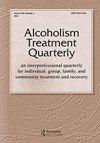Examining Interhemispheric PFC Connectivity during AUD Abstinence with Multilevel Modeling
IF 0.9
Q4 SUBSTANCE ABUSE
引用次数: 0
Abstract
ABSTRACT Objective The prefrontal cortex (PFC) is a communicative network involved in information processing and behavioral regulation and is crucial to understanding the impact of alcohol use disorders (AUD). Functional interhemispheric connectivity across PFC regions may be important aspect of networking while seeking abstinence from AUD. This study examines functional PFC activation of persons seeking continued abstinence from AUD to explore potential interhemispheric connectivity in response to alcohol cues and how such connectivity is associated with abstinence duration. Method This study analyzed cerebral blood flow from PFC regional associations or couplings of 46 persons seeking continued abstinence from AUD were presented with alcohol and other affective cues. Intraclass correlations calculated using multilevel modeling (MLM) served as a measure of functional interhemispheric connectivity. Results Connectivity was found in response to alcohol and other affective cues. Results also suggest that interhemispheric connectivity in response to alcohol cues is negatively associated with abstinence duration. Conclusions Findings of this study suggest that functional interhemispheric connectivity may be important during the processing of alcohol-related cues for persons seeking continued abstinence from AUD. Abstaining from consumption in the early stages of abstinence may be a particularly high demand task requiring both PFC hemispheres, with this need decreasing as abstinence length increases.用多层模型研究AUD戒断期间大脑半球PFC连通性
摘要目的前额叶皮层(PFC)是一个参与信息处理和行为调节的交流网络,对理解酒精使用障碍(AUD)的影响至关重要。PFC区域之间的功能性半球间连接可能是寻求戒断AUD时建立网络的重要方面。本研究考察了寻求持续戒断AUD的人的功能性PFC激活,以探索对酒精提示的潜在半球间连接,以及这种连接如何与戒断时间相关。方法本研究分析了46名寻求持续禁欲的AUD患者的PFC区域关联或耦合的脑血流量,这些患者具有酒精和其他情感线索。使用多级建模(MLM)计算的类内相关性用作功能半球间连接性的测量。结果在对酒精和其他情感线索的反应中发现了连通性。研究结果还表明,大脑半球间对酒精线索的连接与禁欲时间呈负相关。结论这项研究的结果表明,对于寻求持续戒酒的人来说,在处理酒精相关线索的过程中,功能性半球间连接可能很重要。在戒酒的早期阶段戒酒可能是一项特别高的任务,需要两个PFC半球,随着戒酒时间的增加,这种需求会减少。
本文章由计算机程序翻译,如有差异,请以英文原文为准。
求助全文
约1分钟内获得全文
求助全文
来源期刊

Alcoholism Treatment Quarterly
SUBSTANCE ABUSE-
CiteScore
1.60
自引率
11.10%
发文量
31
期刊介绍:
Alcoholism Treatment Quarterly is an exciting professional journal for clinicians working with persons who are alcoholic and their families. Designed to bridge the gap between research journals and information for the general public, it addresses the specific concerns of professional alcoholism counselors, social workers, psychologists, physicians, clergy, nurses, employee assistance professionals, and others who provide direct services to persons who are alcoholic. The journal features articles specifically related to the treatment of alcoholism, highlighting new and innovative approaches to care, describing clinical problems and solutions, and detailing practical, unique approaches to intervention and therapy.
 求助内容:
求助内容: 应助结果提醒方式:
应助结果提醒方式:


